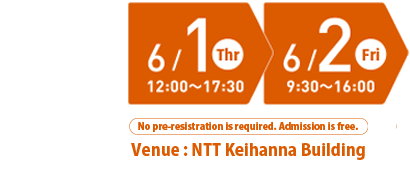
Director's Talk
Thursday, June 1st 13:20-13:50
Basic Research in the Age of AI×IoT×BigData
- New Design of R&D Processes by the Blending of Science and Engineering -
Eisaku Maeda, Director, NTT Communication Science Laboratories
Abstract
Future Emerging from Convergence of AI, IoT, and Big Data
Convergence of three fundamental technologies?new data technology known collectively as AI (Artificial Intelligence), new data infrastructure called IoT (Internet of things), and vast collections of data of unprecedented size and quality called Big Data?are now having a major transformative impact on the world. Yet today we can only foresee a tiny fraction of the services and technologies that might arise in the years ahead, so we must rack our collective brains to come up with ideas of possible applications and impacts on society. Convergence of AI × IoT × BD will open the way to global-scale technological infrastructure in two basic ways: "digitalization of information" permitting "precise" replication of data, and "global networking" that enables "simple" accumulation and dissemination of data. Building on this infrastructure, we now poised to create a new future with machine learning and algorithms for processing information.
Decoding, Exploring, Designing
Data encompassing everything under the sun?people, things, environments?are acquired, decoded, explored, then designed and fed back to society. Intelligence is modeled from every conceivable type of data?writings, actions, speech, images, sounds, biological reactions, muscle activities, brain activities, and so on?related to real people. As this process unfolds, the day is fast approaching when intelligence can be broken up and reassembled as components that can be treated as products on the open market.
Pure science and engineering have always been pursued as independent disciplines, but this is now undergoing an major change caused largely by the developments outlined above. Now, with the availability of low-cost sensing and intelligence, we are able to amass vast amounts of basic scientific data across a wide range of fields within a remarkably short period of time, which can readily be applied to engineering tasks thanks to more reliable processing and analysis. But at the same time, this is creating a need for people who are skilled in reading raw data, designing experimental plans, and other empirical sciences in engineering fields such as signal processing, data analysis, and so on. The former might be called engineering of science, while the latter is science of engineering. Feedback loops from science to engineering to implementation and back to science become ever thicker and the sequence revolves at an ever faster rate. So, even areas of scientific research that up to now have been conducted in idyllic independence, must be strategically reexamined in terms of overall economic efficiency.
Pure science and engineering have always been pursued as independent disciplines, but this is now undergoing an major change caused largely by the developments outlined above. Now, with the availability of low-cost sensing and intelligence, we are able to amass vast amounts of basic scientific data across a wide range of fields within a remarkably short period of time, which can readily be applied to engineering tasks thanks to more reliable processing and analysis. But at the same time, this is creating a need for people who are skilled in reading raw data, designing experimental plans, and other empirical sciences in engineering fields such as signal processing, data analysis, and so on. The former might be called engineering of science, while the latter is science of engineering. Feedback loops from science to engineering to implementation and back to science become ever thicker and the sequence revolves at an ever faster rate. So, even areas of scientific research that up to now have been conducted in idyllic independence, must be strategically reexamined in terms of overall economic efficiency.
Who Steers the Real World
The AI boom will eventually loose momentum, but even at a slower pace will continue to make steady progress. But what ultimate vision can we anticipate in the future? Just as Marvin Minsky, the father of artificial intelligence, sought to peer inside the brain to unravel the secret of intelligence, soon it should be possible for ordinary non-specialists to easily access and view the world's data. Going well beyond mere sounds and photographic images, people will be able to view and manipulate and control a full range of decoded data. Even today we see young children, only two and three years old, who are surprisingly adept at playing with tablet computers and watching YouTube videos and other content. In much the same way, we can fairly assume that you and I?ordinary people?will be able to navigate real world data with nothing more than a tablet computer in the not-too-distant future. Whether this is good or bad, it certainly suggests that we are moving toward a more open democratization of information.
Photos
Speaker

Eisaku Maeda
Director, NTT Communication Science Laboratories

